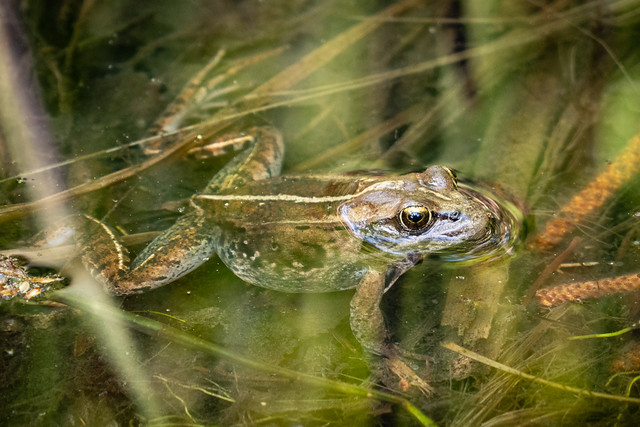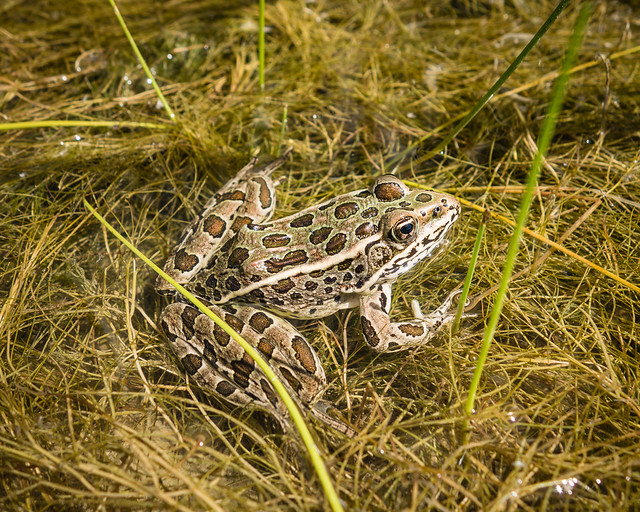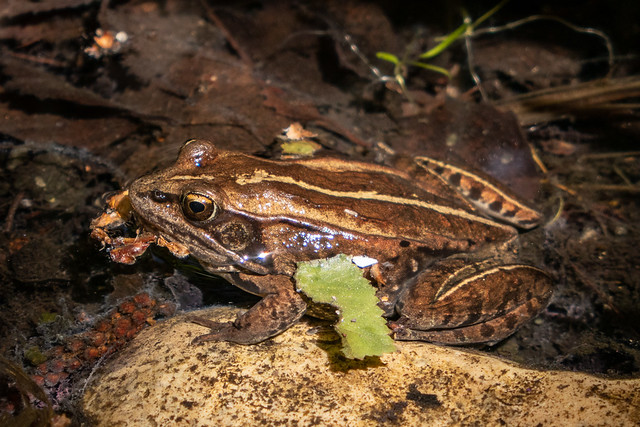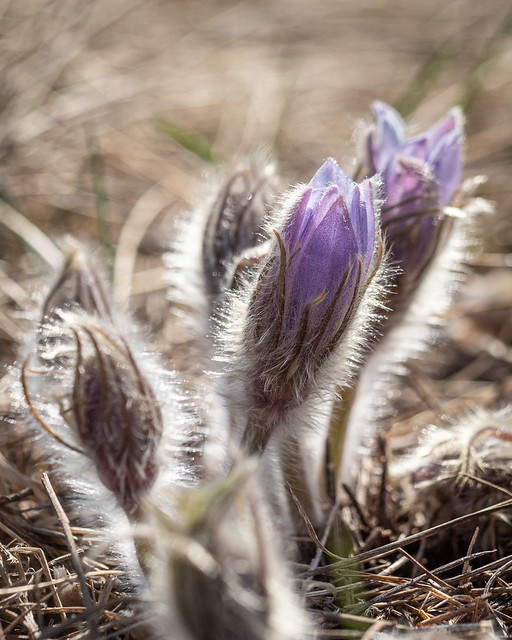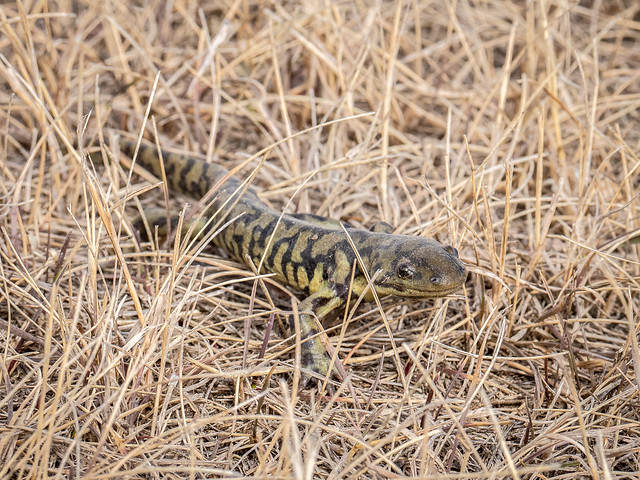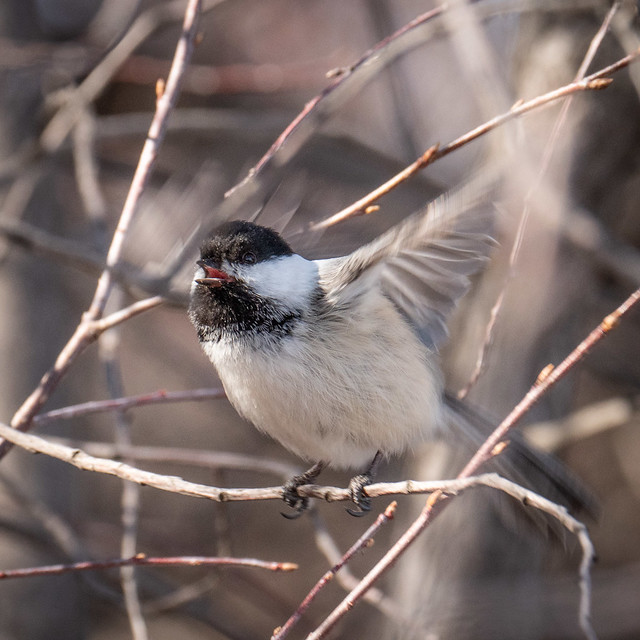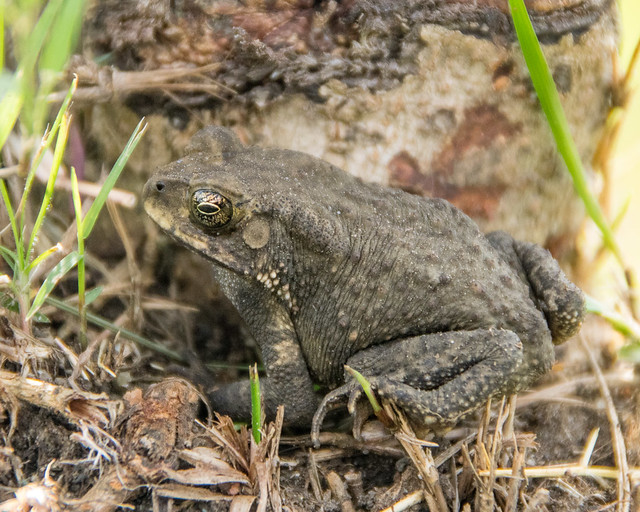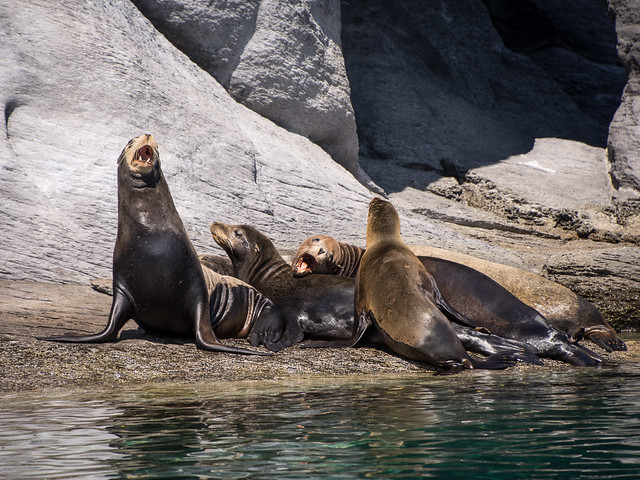Thursday, 30 April 2020
Saskatchewan's Frogs and Toads
There are 6 species of frogs and toads in Saskatchewan.
Boreal Chorus Frog
Boreal Chorus Frog are hard to see but easy to hear, especially in early spring when the males sing day and night to attract females and to defend their territory. The chorus of high-pitched trills has been compared to a fingernail running along the edge of a plastic comb.
Boreal Chorus Frog are small (just under 4 cm), smooth-skinned frogs. They are grey-green to brown with 3 dark stripes down their back, a dark stripe through their eyes, and a white stripe along their upper lip. They’re usually found in small, shallow, fish-free ponds surrounded by short, grassy vegetation in both prairie and forest settings.
The females lay their eggs in clusters, and they hatch in 1-4 weeks. The tadpoles turn into frogs after about 2 months.
Boreal Chorus Frog can be found from British Columbia to Quebec and up into the Yukon and the Northwest Territories as well as in the central United States as far south as Arizona. In winter, they try to find a mammal burrow or other underground cave below the frost line where they can safely hibernate.
Northern Leopard Frog
Northern Leopard Frog owe their name to the dark round spots on their green and brown back and legs. Prominent light-coloured folds of skin run down either side of their back, and they have a white belly. They are a medium-large frog, up to 11 cm in length.
Northern Leopard Frog are found near ponds and marshes across Canada and in most parts of the United States. They can be found as far north as Great Slave Lake and in the mountains. They are also known as Meadow or Grass Frog because they sometimes hop up onto lawns and golf courses in the summer when they've finished breeding.
Northern Leopard Frog will eat anything they can fit in their mouth and have been known to eat small birds and snakes. They sit still, wait for their prey, and then leap and grab it with their long, sticky tongue.
Wood Frog
Wood Frog are reddish-brown, medium-sized (3-8 cm long) frogs with prominent ridges on their back, a black mask over their eyes, and a white belly. Some have a white stripe down their back. They can change colour very rapidly, turning dark when cold to absorb more heat.
Wood Frog are found in every province and territory of Canada as well as the northeastern and central United States. They are the only frog found north of the Arctic Circle and are one of the few frogs found in Alaska. They prefer moist woodland areas and hibernate under the leaf litter covering the forest floor.
Like several northern frogs, including the Boreal Chorus Frog, Wood Frog tolerate below-zero temperatures by increasing the amount of glucose in their blood, which lowers the freezing point and stops ice crystals from forming.
Male Wood Frogs announce the start of the early spring breeding season with small clucking sounds. Over a short 1-2 week period, the frogs will mate and the females will each attach up to 2,000 eggs to underwater vegetation. The tadpoles eat plants, while the adults use their long, sticky tongue to capture insects, spiders, slugs, worms, and snails.
Canadian Toad
Canadian Toad are found in river valleys and around lakes in the grasslands, aspen parklands, and boreal forest of the Canadian prairies and south to the Dakotas and Minnesota. They’re medium-sized (up to 9 cm) and grey-green to brown with brownish-red warts. Unlike the Great Plains Toad, they have grey spots on their light-coloured belly and the raised ridges on their head join to form a bump between their eyes.
Canadian Toad are easiest to spot in the spring when they congregate at breeding ponds. The males call to the females with a high-pitched trill that repeats every 15-20 seconds. Once breeding season is over, the toads spread out into the grasslands and aspen parklands, although they generally stay close to water. Their mottled earthy colors are good camouflage.
Canadian Toad hibernate underground below the frost line in burrows they've dug using the bony lumps on their rear legs.
Great Plains Toad
Great Plains Toad are medium-large (up to 11 cm), ranging in colour from pale brown-grey to olive, with dark blotches and numerous small warts. Unlike the Canadian Toad that share the same habitat, Great Plains Toad have a solid white belly and the L-shaped ridges around each eye fuse in a V rather than a lump between the eyes.
Great Plains Toad can be found in the grasslands of southern Alberta, Saskatchewan, and Manitoba and south into the central plains of the United States. They breed in temporary pools, ditches, and dugouts, laying long strings of up to 20,000 eggs. The eggs hatch in about 2 days and the tadpoles turn into frogs after 6 weeks.
Great Plains Toad hibernate in underground burrows from October to April. They are more active at night and escape the heat of the day by digging shallow burrows in loose soil. During a severe drought, they can remain inactive underground for extended periods of time.
Great Plains Toad have large home ranges and can travel over a kilometer between breeding sites, summer habitats, and hibernation sites. When threatened, they puff themselves up with air, lift themselves up on all 4 legs, and lower their head. Poisonous secretions in their warts and the large glands behind their eyes help to deter predators.
Plains Spadefoot Toad
Plains Spadefoot Toad can be found on short-grass prairie from southern Alberta, Saskatchewan, and Manitoba south through the central plains to New Mexico, Oklahoma, and West Texas. They have a round body (up to 6.5 cm), short legs, a bony lump between the eyes, and a vertical pupil. They are tan to dark brown with small orange/yellow spots and a white belly. They often have 4 white stripes down their back.
Plains Spadefoot look like a frog. Unlike the Canadian Toad and the Great Plains Toad, their skin is relatively smooth and moist. They have a vertical rather than a horizontal pupil and lack the large parotoid glands behind the eyes.
Plains Spadefoot are hard to spot as they are nocturnal and spend much of their time buried in the sand to conserve moisture. They come out at night to hunt for beetles, crickets, and grasshoppers. Plains Spadefoot tunnel backwards using the sharp knobs (or spades) on their hind feet. Their tunnels can extend as much as 1 meter – no wonder they prefer sandy or gravel soil that is easier to dig.
See Also
10 Surprising Facts about Frogs and Toads
Saskatchewan’s Snakes
Nature Companion, a Comprehensive Nature App for Canada's four Western Provinces
You can follow EcoFriendly Sask by liking us on Facebook, following us on Twitter, or by email (top right corner).
Tuesday, 28 April 2020
EcoSask News, April 28, 2020
Upcoming Events (online)
Zoo Society AGM, May 3
The Saskatoon Zoo Society will be holding a virtual annual general meeting at 1:30 pm, May 3.
Deep Building Retrofits, May 6
Rod Yoed will discuss deep building retrofits for energy and carbon at the 7:30 am, May 6, online meeting of the Saskatchewan Energy Management Task Force.
World Migratory Bird Day, May 9
Share photographs and stories about birds as Migratory Bird Day goes online on Saturday, May 9.
More and more events are going online. Be sure to check the EcoFriendly Sask Calendar for details.
Local News
Yellowhead Flyway Birding Trail’s summer program plans to build an online nature community through a Facebook group to share ideas and a website to provide resources.
A new study will determine the presence or absence of microplastics in the South Saskatchewan River watershed.
The Alternative, a zero-waste and refillery store, has opened in Regina.
Educational Resources
SOS Trees Coalition has a brand-new website covering tree care, threats to trees, benefits of trees, tree tours, and more.
Earth Rangers has launched The Big Melt, a 10-episode podcast for teens and tweens addressing climate change and its impact on youth.
Wildsight has put together a homeschooling newsletter and resources, including concrete ideas from homeschooling parents, that connect kids with nature and gets them outdoors.
A journey of billions of miles – stargazing from your backyard.
Check out Earth Tongues, a blog of independent voices from The Ecological Citizen.
From Information to Action
The Covid lockdown has affected transportation worldwide. Can we apply what we’ve learned to accelerate climate action?
The normal economy is never coming back. “It makes sense to call . . . for a more active, more visionary government to lead the way out of the crisis. But the question, of course, is what form that will take and which political forces will control it.”
“Ducks in the streets of Paris are a sign that nature is all around us. . . . It’s high time we give nature the attention it deserves.”
Strengthening and maintaining urban nature connections – trees, pollinators, dark skies – through law, policy, and individual stewardship.
Electric thermal storage units will help smooth out peaks in demand, reducing the need for diesel and LNG generators in Whitehorse, Yukon.
Changes to keep cities functioning after lockdown could show that pro-pedestrian policies were not urbanist fantasies but durable, practical ways to build a livable post-pandemic urban future.
The Power of Art
The power of a photograph – 6 conservation photographers talk about their work.
Artists are drawing attention to climate change, species loss, and pollution in US national parks.
21 books, both fiction and non-fiction, about climate change.
That’s Amazing!
Scientists are studying owl wings to design quieter airplanes, fans, and wind turbines.
Black rhinos have terrible eyesight, but the oxpecker birds riding on their backs and feasting on ticks warn them of approaching poachers.
An insect chastity belt, shrew venom, wax on bird wings – surprising facts about common backyard wildlife.
With no tourists, Australian scuba tour companies are planting coral.
EcoSask News is a weekly round-up of local news and events. Email us if you have items you would like us to include.
You can follow EcoFriendly Sask by liking us on Facebook, following us on Twitter, or by email (top right corner).
Labels:
Art,
Astronomy,
Birds,
Construction,
Economy,
Education,
Energy,
Photography,
Plastic,
Transportation,
Trees,
Urban,
Urban Wildlife,
Walking,
Waste,
Water,
Zoo
Tuesday, 21 April 2020
EcoSask News, April 21, 2020
Earth Day (April 22) Events (online)
Drive Electric Meetup
Join Plug In America, Sierra Club, and the Electric Auto Association for a virtual event from 12-1 pm honouring EVs and their positive impact on the planet.
Endlings
Joanna Lilley will launch her new collection of poetry about extinction at an online panel discussion at 7 pm in Saskatchewan.
5Point Unlocked
Join host Chris Davenport for 90 minutes of films that shine a light on the wild places within and without at 7 pm.
Earth Day Songs
Join Glen Sutter for a Facebook Live evening of original tunes and writing at 7 pm and raise money for local environmental action.
Additional Events (online)
Yard Waste, Apr. 21-Nov.10 (Swift Current)
Swift Current’s Yard Waste program runs from April 21 to November 10 with a few modifications for physical distancing restrictions.
Imagining the Green New Deal, Apr. 23
Join the Council of Canadians in imagining a Green New Deal at 5 pm, Apr. 23.
Wildlife Rescue, Apr. 25
The Wildlife Rehabilitation Society of Saskatchewan is holding an online volunteer orientation session at 2 pm, Apr. 25.
EnviroCollective, Apr. 27
EnviroCollective Regina is meeting online from 7-9 pm, Apr. 27.
Environmental Society AGM, Apr. 27
The Saskatchewan Environmental Society is holding its annual general meeting online at 7 pm, Apr. 27.
Citizen’s Guide to Climate Success, Apr. 28
Mark Jaccard, professor of sustainable energy, will speak on how climate-concerned citizens can overcome myths that hinder us from acting in time to prevent extreme climate impacts at 2 pm, Apr. 28.
Enviro Law 101, Apr. 30
West Coast Environmental Law is offering a youth-focused workshop on using the law to protect the environment and tackle climate change from 12-1 pm, Apr. 30.
More and more events are going online. Check the EcoFriendly Sask Calendar for details.
In the News
A revised edition of Prairie: A Natural History of the Heart of North America by Candace Savage has just been released. Find out more about the book and the author in these interviews. Candace describes the prairies as “a world that needs to be appreciated in miniature, ideally on hands and knees with your nose in the grass.” The book “gives you the information and insights you need to go exploring.”
Federal funding for cleaning up orphan oil and gas wells will create employment but puts taxpayers on the hook for costs that were supposed to be paid by the oil and gas industry.
Tens of millions of radicals, moderates, and conservatives took part in Earth Day 1970.
A new app, Earth Challenge 2020, hopes to use millions of people around the world to monitor environmental problems, including plastic and air pollution.
Just for Fun
Andrew spotted a tiger salamander while there was still snow on the ground in Saskatchewan!
Red-winged blackbirds are eavesdropping on yellow warblers.
We knew ravens were smart, but this is pretty impressive! “Y’all right love?”
Bats can be pretty darn cute – see if you don’t agree!
Celebrating National Volunteer Week
Rick Huziak: The High Cost of Lighting up the Night
Branimir Gjetvaj: Conservation Photographer
Citizens Environmental Alliance – Saskatchewan: We’re Losing our Wetlands and That’s a Big Problem
Repair Café Prince Albert
Melanie Elliott: Taught by Nature: The Importance of Outdoor Education
Jared Clarke: Naturalist and Climate Change Activist
Claire Bullaro: Zoos are for Education
EnviroCollective Regina
Meghan Mickelson: Nature through the Camera Lens
EcoSask News is a weekly round-up of local news and events. Email us if you have items you would like us to include.
You can follow EcoFriendly Sask by liking us on Facebook, following us on Twitter, or by email (top right corner).
Labels:
Advocacy,
Bats,
Birds,
Books,
Earth Day,
Economy,
Films,
Law,
Light,
Oil,
Photography,
Regina,
Transportation,
Volunteers,
Wildlife Rehab,
Zoo
Tuesday, 14 April 2020
EcoSask News, April 14, 2020
Online Events & Resources
Beavers as a Natural Infrastructure Solution, Apr. 20 (online)
Find out how to harness beavers’ ability to assist with water storage, flood/drought risk reduction, and quality of life in a one-hour webinar from Cows & Fish and the Miistakis Institute at 11 am, Apr. 20. The webinar targets municipal planners, engineers, and related professionals and practitioners.
Earth Day Songs, Apr. 22 (online)
Join Glen Sutter for a Facebook Live evening of original tunes and writing on Earth Day, Apr. 22, at 7 pm, and raise money for local environmental action.
One Ocean Connects Us
Ocean School’s website uses storytelling, technology, and interactive media to help kids and adults understand our influence on the ocean and the ocean’s influence on us.
Local News
A new U of S smartphone app will help identify freshwater hotspots of nutrient contamination and encourage remedial action to reduce pollution.
The City of Saskatoon has partnered with the University of Saskatchewan to evaluate what contaminants may be entering the local river systems through stormwater.
From Information to Action
“The major impact of coronavirus on the trajectory of climate change . . . must be a collective recognition that rapid and significant voluntary changes in our behavior are possible.”
“The complete decarbonization of the global energy supply will be an extremely challenging undertaking of an unprecedented scale and complexity that will not be accomplished . . . in a matter of a few decades.” (Vaclav Smil, international authority on energy transitions)
The coronavirus crisis highlights three gaps in parks equity: accessibility, funding, and space.
That’s Amazing!
Birds practise social distancing – here’s why.
Research into plant cognition is once again achieving legitimacy within the scientific community.
David Bamberger: “My objective was to take the worst piece of land I could possibly find in the hill country of Texas and begin a process of restoration that would turn it back to one of the best. And that has happened."
EcoSask News is a weekly round-up of local news and events. Email us if you have items you would like us to include.
You can follow EcoFriendly Sask by liking us on Facebook, following us on Twitter, or by email (top right corner).
Thursday, 9 April 2020
10 Surprising Facts about Frogs and Toads
1. Toads and frogs have a lot in common. In fact, toads are a type of frog. But there are some differences. Most frogs have long legs and smooth, moist skin. Toads have shorter legs and their skin is dry and bumpy. Frogs lay their eggs in a clump that looks like a bunch of grapes. Toads lay long strands of eggs on underwater plants. Frogs have teeth; toads don’t.
2. Tree frogs don’t always live in trees, but all of them have toe pads to help them grip and climb. Some tree frogs are small and brightly coloured like the tropical Red-eyed Tree Frog. Others, like the Pacific Tree Frog that can be found in British Columbia, are green and beige and blend in well with their surroundings.
3. Frogs have lungs, but they can also breathe and absorb water through their skin. A thin layer of mucus keeps their skin moist and protects it from scratches.
4. Frogs can’t turn their head because they don’t have a neck. What they do have is a vocal sac, a large bubble that expands below the head and above the neck. The sac can be 3 times as large as the frog’s head when it’s fully expanded and is full of air. Male frogs use the vocal sac to make their voice louder to attract a mate and defend their territory from other males.
5. The world’s smallest frog lives in Papua New Guinea and is only 7 mm long. The world’s largest frog is the Goliath frog of Cameroon and Equatorial Guinea. It’s 30 cm long and weighs 3 kilograms. Male Goliath frogs have been known to build their own ponds for the females to nest in. Using their very muscular hind legs, they make a depression in the riverbank and surround it with large stones weighing up to 2 kg.
6. Frogs are really good at jumping. Some can jump as much as 8 times their body length. Scientists have learned that frogs have a special joint that lets them unfold like a flip phone. Their legs and body line up like an arrow, ensuring both power and accuracy.
7. The bumps on a toad’s back are glands. Some produce mucus to keep the toad’s skin moist when they’re out of the water. Others are granular glands which contain toxins to deter predators. American toads have a cluster of granular glands, known as parotoid glands, just behind their eyes. If they’re threatened, the toads lower their heads so that the first thing the predator will encounter is the poison-filled glands. The poison can cause serious inflammation of the predator’s eyes or throat as well as vomiting.
8. Frogs like to be together. Young frogs even swim together in schools like fish. A group of frogs is called an army, colony, or knot.
9. Millions of frogs were born each year after the Nile river flooded, so the early Egyptians associated frogs with fertility. Similarly, First Nations peoples of the Pacific Northwest view frogs as a symbol of springtime, cleansing, and rebirth.
10. People used to believe that swallowing a live frog could cure whooping cough and tuberculosis, while carrying a dried frog in a pouch around your neck would prevent epileptic seizures.
See Also
Saskatchewan's Frogs and Toads
8 Cool Facts about Bats
10 Surprising Facts about Pigeons
10 Surprising Facts about Beavers
Snakes of Saskatchewan
Nature Companion, a Comprehensive Nature App for Canada's Four Western Provinces
You can follow EcoFriendly Sask by liking us on Facebook, following us on Twitter, or by email (top right corner).
Tuesday, 7 April 2020
EcoSask News, April 7, 2020
Local News & Events
Changing the Climate, Apr. 11 (online)
Everyone is invited to join an online field trip from 1-3:30 pm, Apr. 11, in which U of R students share work from the multidisciplinary course, Engaging Climate Change: Creativity, Community, Intervention.
WILD Outside (Regina, Saskatoon)
WILD Outside, a national conservation-based youth leadership program designed for youth ages 15 to 18, is now recruiting for Saskatoon and Regina. Youth who join the program will explore the outdoors through a variety of activities (hiking, cross country skiing, and canoeing, to name a few) and plan and carry out community-based conservation action projects.
While COVID 19 currently prevents participants from gathering together in person, WILD Outside facilitators are adapting the programming to bring people together virtually across the country.
Go to http://wildoutside.ca/ for more information and to fill out the online inquiry form.
Buffalo Pound
The Nature Conservancy of Canada’s plan to protect shoreline and grasslands at Buffalo Pound is important for species at risk and water quality for surrounding communities.
Urban Wildlife
The Wildlife Rehabilitation Society of Saskatchewan is reminding the public that trapping and relocating wild animals is not a humane solution. “By relocating an animal, we are likely placing them in unfamiliar territory without any known food, water or shelter. Not only is this poor animal going to have to fight to find resources – it could be chased off, injured or killed by other animals whose territory they have been place upon! Don’t forget that there’s also the threat of diseases being spread when we relocate animals from one place to another. Bacteria, parasites and viruses can be easily spread and harm or kill a variety of wildlife. And what about babies? Often times, relocating an adult animal means that we are leaving behind helpless and orphaned baby animals who are unable to fend for themselves. Finally - relocating an animal just opens up the space for another animal to move right on in! We really aren’t solving any problems by forceably removing animals from their homes. We understand that wild animals can sometimes be a nuisance – especially if they are in your yard or house. However, we can help you find ways to make your area undesirable so the animal will naturally relocate itself! So please do not relocate any wild animals – give our hotline a call at 306-242-7177 and we’ll be happy to help!”
City birds: big-brained with few offspring or small-brained with a lot.
In the News
“What if concrete could be used to store climate-warming carbon?”
Lockdowns are changing the way the earth moves, making it easier to monitor for earthquake and volcano activity.
From flying foxes to sea lions – nature cams bring nature to your screen.
Want to visit the world’s largest cave or head inside an active volcano – the 10 best natural wonders’ virtual tours.
That’s Amazing!
Squids communicate in the dark ocean by turning their bodies into animated message boards.
Peacock spiders are famous for their rainbow-hued buttocks, elaborate mating dances, and ninja-esque jumping skills.
EcoSask News is a weekly round-up of local news and events. Email us if you have items you would like us to include.
You can follow EcoFriendly Sask by liking us on Facebook, following us on Twitter, or by email (top right corner).
Labels:
Birds,
Construction,
Nature,
Nature Conservancy,
Online,
Regina,
Saskatoon,
University,
Urban Wildlife,
Youth
Subscribe to:
Posts (Atom)
